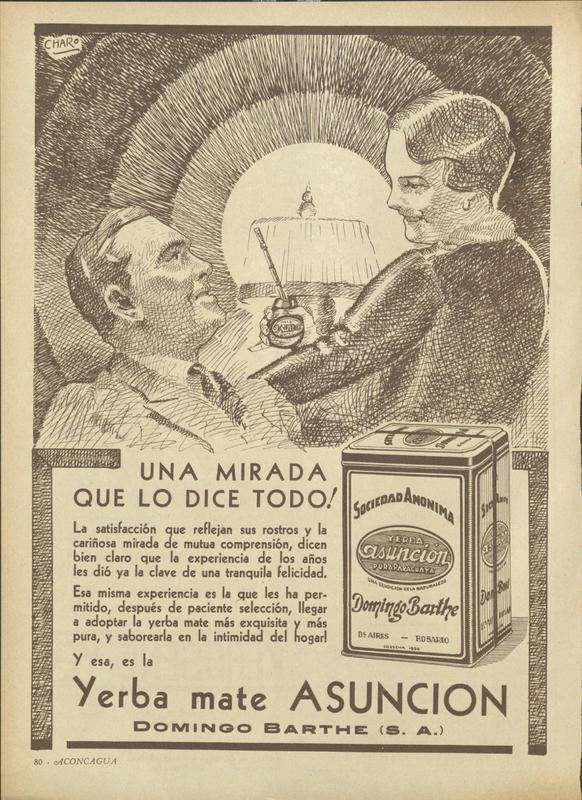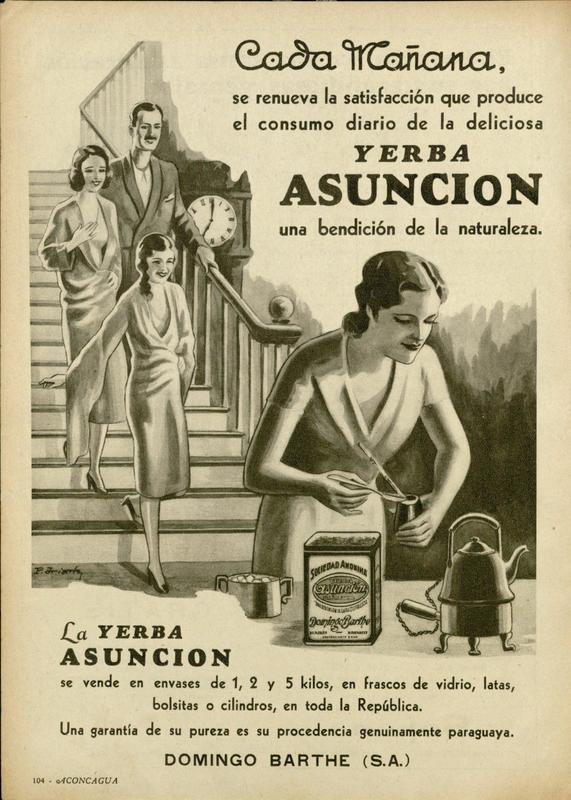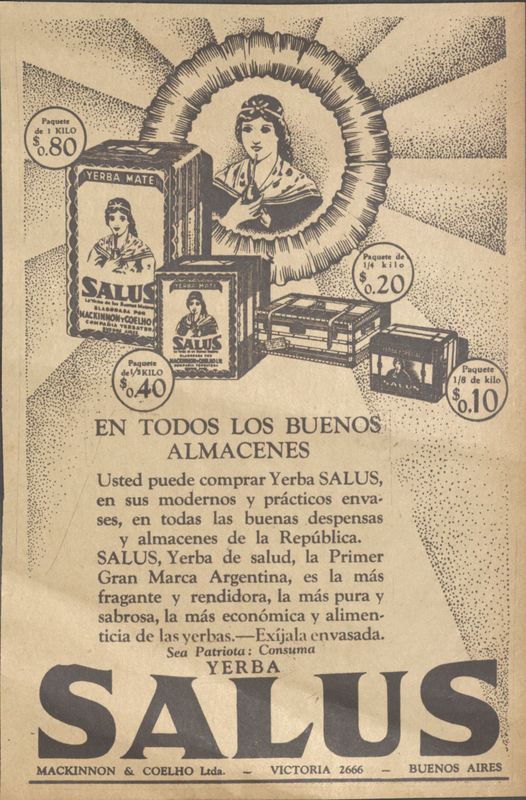Early 20th Century Advertisements: Pre-Peronist Era
As the twentieth century began, the Industrial Revolution had already influenced economic development all over the world. However, full industrialization had still not occurred in Argentina (Milanesio 7). While some developments enabled the rise of a middle class that participated in a consumer market in the 1920s, the lower socioeconomic sector had yet to have a place in the Argentinian world of consumption (Milanesio 9). This was a result of low wages for the working class Argentinian population. In the 1930s, Argentinian workers earned half the income of an English worker and one third the income of a US worker (Milanesio 20). Thus, low earnings prevented the working class from spending money on consumer goods and subsequently contributing to the Argentinian economy. This meant that mass consumption in Argentina was not possible and the internal economy was too small to foster full industrial development (Milanesio 23). Lack of internal economic development meant that Argentina was subject to foreign influence, which extended to the world of advertising.
The lack of purchasing power among the working class, left only middle and upper class Argentinians for advertisers to market to in the first half of the twentieth century. As a lack of national industry meant that national identity in Argentina remained rather undeveloped, no real national advertising existed in the beginning of the century. Instead, Argentine marketers reproduced foreign advertising formulas. Experts claim that early twentieth century Argentine advertising “was characterized by deficient translations, inappropriate sales arguments, and a profound lack of information on Argentine traditions and culture,” (Milanesio 71). Thus, themes from the industrialized west of convenience, modernity, and comfort attracted middle and upper class Argentinian consumers (Milanesio 71). These marketing techniques were evident among early twentieth century Argentine yerba mate advertisements.
This 1932 Yerba Asuncion mate advertisement conveys themes of modernity and comfort. The couple is dressed in nice, modern attire, illustrating the ideal wealthy consumer. The couple is also depicted in a room that – as indicated by the lamp – is not the kitchen. This implies that rather than being solely for consumption, this mate allows Argentinians to relax and enjoy the comforts of an increasingly developed world. The shading around the couple accentuates the gourd of mate and the bombilla. When consuming mate, the bombilla (a straw used to consume and filter the mate) is generally shared among all consumers. Here, the emphasis on the gourd and bombilla connote an intimate relationship between the husband and wife. Both husband and wife share a look of adoration and satisfaction. In the 1930s, marriage and domesticity was the social norm. Here, the advertisement is selling marital bliss along with the mate itself to an upper class population. The text in the advertisement focusses on the look that implies the strong marital relationship as it translates to “A LOOK THAT SAYS EVERYTHING! The satisfaction that reflects their faces and affectionate look of mutual understanding…that same experience has allowed them, after patient selection, to adopt the most exquisite and purest mate, and taste it in the intimacy of the home.” The text equates marital experience – something valued in Argentine society – to the experience necessary in choosing a mate brand. This gives the couple credibility in their mate selection. The text also equates the satisfaction of marital relationships with the satisfaction that comes from consuming Yerba Asuncion.
The shading in the image gets lighter as it approaches the gourd of mate. The area surrounding the mate is white, and the hand of the woman holding the gourd even interrupts the pattern of the darker shades as it is engulfed by white. This subtle coloring along with words like “pure” and “exquisite” push the reader to associate the image with the purity of marriage and Yerba Asuncion mate. The emphasis on marriage and purity brings up the issue of gender roles displayed in yerba mate advertisements in the early twentieth century. The mate is often feminized, as the target audience was middle and upper class women. Here, the woman is the one holding the mate, therefore initiating the connection between her and her husband. As conveyed by Parkin in reference to US advertising, it was seen as the woman’s job to provide quality food to her husband and initiate connection (Parkin). In this advertisement, the woman is offering the nourishment and affection to her husband. The emphasis on the quality of the mate encourages women to make this choice for her and her husband. The reflection of American advertising themes in Argentine advertisements was common in the early twentieth century (Milanesio). Here we see the association of women with nourishment as well as themes of modernity. The packaging of the mate itself is depicted in a modern tin with aesthetically pleasing font. Milanesio’s characterization of “deficient translations” is also reflected here with the lack of an inverted exclamation mark in the first sentence as well as a missing accent mark on the word Asunción.
The same themes of modernity, femininity, and elitism are reflected in this 1932 Yerba Asuncion advertisement. Because the site of production is the same in both advertisements, similar advertising formulas are inevitable. For example, the company that produced both advertisements is a Paraguayan company marketing to Argentinians. Paraguayan companies often emphasized the superior quality of their mate. Argentina became the largest mate consumer and producer in the early twentieth century, forcing Paraguay to focus on quality over quantity (Folch). Also, the reflection of western advertising formulas and a complete lack of Argentine national identity was likely to be more common among Paraguayan companies. However, the prominence of the Paraguayan brand itself as well as its themes is relevant as it reflects a lack of Argentine national advertising and subsequent US influence.
This advertisement features one man and three women, all depicted in elegant attire. The women are emphasized, as one of them prepares the yerba mate. This presents an image of an ideal modern consumer: a middle or upper class woman. There is also a large staircase and a grandfather clock, further indicating wealth and privilege. One woman is featured in the foreground with the mate. As the woman prepares the mate with her hair and makeup done, the mate is feminized, as an elite female audience is targeted. The advertisement is also selling modernity in post industrial revolution period. The dress of the man and the women is a more modern style and the tin of the mate has modern features. Like the other advertisement, the text in this image emphasizes the satisfaction that the mate will bring consumers. However, the text beneath the image differs from the previous advertisement, as it discusses the types of packaging that the mate is available in. This highlights convenience along with modernity. This caters to a middle and upper class audience looking to make daily activities easier and more comfortable.
This Salus advertisement for yerba mate published in the 1920s differs from the other two early twentieth century advertisements. It follows similar advertising formulas – likely adopted from western advertising – with a relatively large block of text along with a large image. This image features a woman known as la china: a rural indigenous woman commonly associated with gauchos (rural Argentinian cowboys) (Pite 8). While la china originally referred to female animals, the Spanish applied the term toward “supposedly uncivilized indigenous women,” (Pite 7). The image of la china reflected gender roles in Argentinian society, as it was used to portray rural women as “sexually available and inferior to their men,” (Pite 9). The lined pattern combined with the frame and shading draws the potential consumer’s eyes directly toward la china. The woman’s face appears repetitively on each packaged item as if the advertisement is selling the woman along with the mate. The idea of la china was often alluring to men, for she was known to put a man’s needs ahead of her own. Here, the depiction of la china alone is rather unusual. In the context of yerba mate, la china has historically been pictured with a man, more specifically a gaucho, often serving him the mate (Pite). The depiction of the woman alone serves to feminize the mate itself. The image implies that the mate, like the woman, is alluring and feminine. This illustration also supports Milanesio’s claim that early twentieth century advertisements often replicated foreign formulas with insufficient knowledge of Argentinian culture.
This advertisement implements different techniques than those of Yerba Asunción. While the previous two advertisements emphasized the quality of the mate itself, this advertisement seems to focus on the nationalism associated with its brand. This is a result of the origins of the different brands. In the early twentieth century, Paraguayan mate was known to be higher in quality, while Argentinian mate was higher in quantity (Folch 26). Both countries marketed mate toward Argentinian consumers as Argentina became the largest mate consumer in the world (Folch). Competing with the quality of Paraguayan brands such as Yerba Asunción, Argentinian brands like Salus appear to connote consuming domestic mate with patriotism. This is further emphasized by the phrases “Sea Patriota” [“Be a Patriot”] and “la Primer Gran Marca Argentina” [The First Great Argentinian Brand], along with the presence of la china, a clearly Argentinian woman. The image contains prices on each packaged product, further distinguishing itself from Paraguayan brands by emphasizing economy over prestige. The copious amount of mate Argentina produced likely made Argentinian brands able to sell the mate at a lower price than Paraguayan brands.
The presence of the prices and depiction of a rural woman seems to indicate a different target audience than the other two early twentieth century advertisements. While the first two images targeted middle and upper class women, the economical focus of this advertisement appears to appeal to a working class audience. This appeal could have been out of necessity for Argentinian brands. The higher quality connotation with Paraguayan mate could have made selling mate harder for Argentinian companies, forcing them to sell at lower prices to include lower socioeconomic sectors as potential consumers. However, this advertisement has several components that parallel an elite tone. The first line of text reads “EN TODOS LOS BUENOS ALMACENES” (IN ALL THE GOOD STORES), implying that higher quality sores sell Salus mate. Additionally, phrases like “modernos” (modern) and “Exíjala envasada” (require it packaged) along with the images of industrial packaging juxtapose a more rural theme.
There is also evidence that the target audience of this advertisement differed from other twentieth century advertising for mate. The phrase “la Primer Gran Marca Argentina” (the First Great Argentinian Brand), particularly the term “Primer) (First), suggests that Paraguayan brands had been dominating mate sales among the upper socioeconomic Argentinian sectors. This could be a way to appeal to middle and upper class consumers while still including the working class. The advertisement essentially conveys that while its Argentinian mate is economical, it is also just as good as higher quality Paraguayan mate.
All of these advertisements show some level of evidence of targetting a middle and upper class audience. This is corroberated by the adoption of foreign advertising formulas, particularly from The United States, the persistance of Paraguayan yerba mate brands, and a lack of purchasing power among lower socioeconomic sectors in the pre-Peronist era. While the last advertisement makes an effort to convey cost saving and nationalistic themes, it keeps with the early twentieth century style -- big blocks of text and modern images of packaging -- likely as a way to capture both a an upper and lower class audience. These images featured in the advertisements feminize the yerba mate, portraying the ideal image of a modern Argentinian woman. This serves to appeal to a feminine audience and give the yerba mate an alluring connotation.



